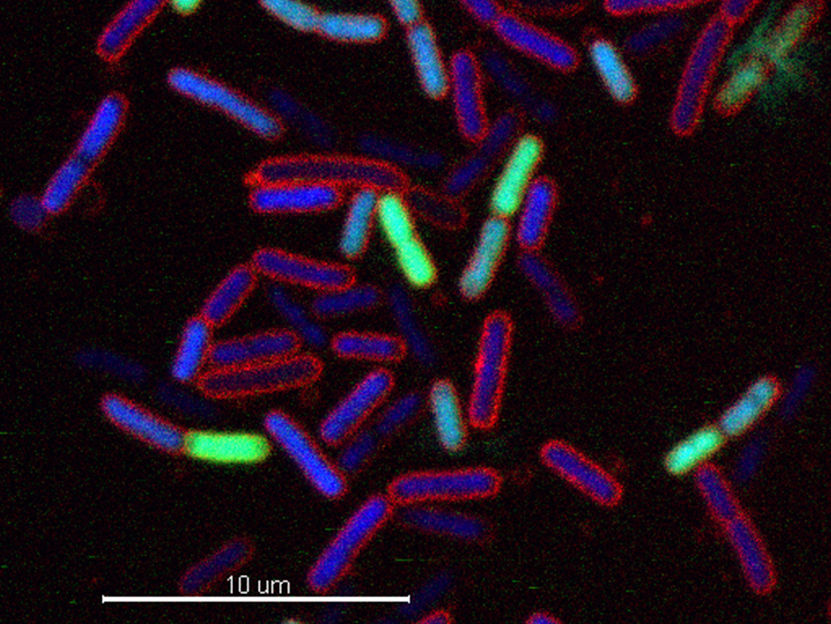Antibiotics with Novel Mechanism of Action Discovered
Many life-threatening bacteria are becoming increasingly resistant to existing antibiotics. Swiss researchers co-headed by the University of Zurich have now discovered a new class of antibiotics with a unique spectrum of activity and mechanism of action – a major step in the fight against antimicrobial resistance. By disrupting outer membrane synthesis, the antibiotics effectively kill gram-negative bacteria.

Escherichia coli cells treated with a novel chimeric peptidomimetic antibiotic. Cells in blue are alive while green cells are already killed by the antibiotic (cell lysis).
Matthias Urfer, UZH
The rapid emergence of antimicrobial resistance is a matter of global concern. According to the World Health Organization (WHO), particularly Gram-negative bacteria like Acinetobacter baumannii, Pseudomonas aeruginosa and Enterobacteriaceae that are resistant to the carbapenem and cephalosporin antibiotics, pose a growing threat to human health. These pathogens can cause severe and often life-threatening infections. The last new class of antibiotics to reach the market against these microorganisms, the fluoroquinolones, dates back to the 1960s. Novel antibiotics with new mechanisms of action against Gram-negative bacteria are urgently needed, especially because resistance against the last resort antibiotic colistin is on a global rise.
Novel family of antibiotics against dangerous bacteria
Swiss research teams headed by the University of Zurich (UZH) and Polyphor AG now report the discovery and characterization of a new family of synthetic antibiotics that possess broad-spectrum anti-Gram-negative antimicrobial activity. "The new antibiotics interact with essential outer membrane proteins in Gram-negative bacteria", says John Robinson from the UZH Department of Chemistry, who co-headed the study. "According to our results, the antibiotics bind to complex fat-like substances called lipopolysaccharides and to BamA, an essential protein of the outer membrane of Gram-negative bacteria", Robinson adds.
Disruption of outer membrane synthesis via unexploited mechanism of action
BamA is the main component of the so-called ß-barrel folding complex (BAM), which is essential for outer membrane synthesis. After targeting this essential outer membrane protein, the antibiotics destroy the integrity of the bacterial membranes and the cells burst. The outer membrane of Gram-negative bacteria has the important function to protect the cells from toxic environmental factors, such as antibiotics. It is also responsible for the uptake and export of nutrients and signaling molecules. "Despite its critical importance, so far no clinical antibiotics target these key proteins required for outer membrane biogenesis", Robinson says.
Lead molecule in preclinical studies
The research was carried out in close collaboration with Polyphor AG, a former UZH start-up company that was founded in 1996. The clinical stage biopharmaceutical company based in Allschwil now plans to progress one compound into human clinical trials. "POL7306, a first lead molecule of the novel antibiotics class, is now in preclinical development", says Daniel Obrecht, chief scientific officer at Polyphor and co-head of the work.
Original publication
Anatol Luther et. al.; "Chimeric Peptidomimetic Antibiotics Against Gram-Negative Bacteria"; Nature; 23 October 2019.
Most read news
Original publication
Anatol Luther et. al.; "Chimeric Peptidomimetic Antibiotics Against Gram-Negative Bacteria"; Nature; 23 October 2019.
Topics
Organizations
Other news from the department science

Get the life science industry in your inbox
By submitting this form you agree that LUMITOS AG will send you the newsletter(s) selected above by email. Your data will not be passed on to third parties. Your data will be stored and processed in accordance with our data protection regulations. LUMITOS may contact you by email for the purpose of advertising or market and opinion surveys. You can revoke your consent at any time without giving reasons to LUMITOS AG, Ernst-Augustin-Str. 2, 12489 Berlin, Germany or by e-mail at revoke@lumitos.com with effect for the future. In addition, each email contains a link to unsubscribe from the corresponding newsletter.

















































